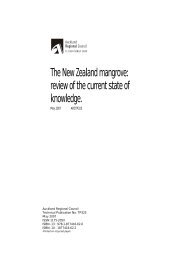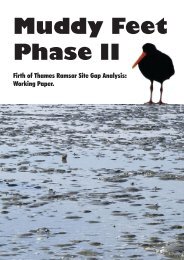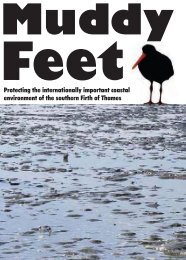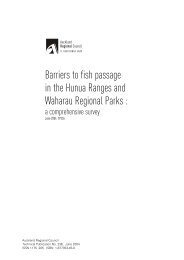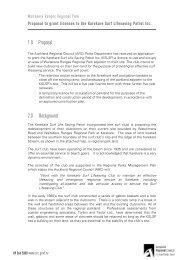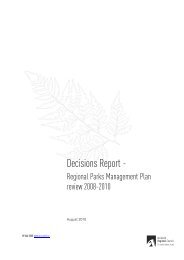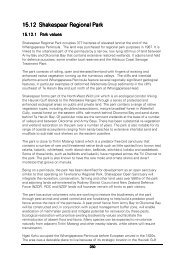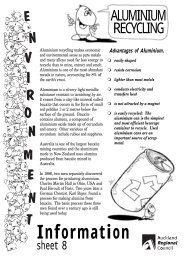archaeology and history of human occupation - Auckland Regional ...
archaeology and history of human occupation - Auckland Regional ...
archaeology and history of human occupation - Auckland Regional ...
You also want an ePaper? Increase the reach of your titles
YUMPU automatically turns print PDFs into web optimized ePapers that Google loves.
44<br />
The Cudlip Point pa-follows the narrow saddle on the headl<strong>and</strong> ridge. Part in<br />
grass <strong>and</strong> part in bush, a formed bush track me<strong>and</strong>ers around numerous pits. The<br />
pits are kept cleared <strong>of</strong> grass <strong>and</strong> are an excellent interpretation feature.<br />
Te Muri Point pa is the most extensive <strong>of</strong> all four sites, also part in grass, part in<br />
bush. The outer grassed zone is defended by ditches, <strong>and</strong> the inner bush zone <strong>of</strong><br />
pits is defended by transverse ditches <strong>and</strong> terraces. The original walking track to<br />
the pa remains.<br />
v<br />
Mahurangi East<br />
This area was surveyed by Clough (1993) <strong>and</strong> Lawlor (1991). 18 sites were<br />
recorded. Pits, terraces <strong>and</strong> midden were located on the ridge behind Big Bay, <strong>and</strong><br />
on the slopes <strong>and</strong> ridges <strong>of</strong> Poplar Bay. Other sites present on Mahurangi Head<br />
include a well preserved ,pa (Davidson 1961), which is not located on parkl<strong>and</strong>.<br />
Occasional middens occur around the coast. Sites <strong>of</strong> historic interest include old<br />
ship-building yards <strong>and</strong> a post-war woolshed at Poplar Bay <strong>and</strong> the old<br />
Kaukapakapa schoolhouse at Big Bay.<br />
Scott Point<br />
This area was surveyed by Clough (1993). 4 sites were recorded, including pits,<br />
terraces, a ditch <strong>and</strong> a midden. Several surveys have also been undertaken in the<br />
immediate area (Morwood 1975, Nicol 1977, Walton 1976). These surveys<br />
showed that most <strong>of</strong> the headl<strong>and</strong>s around the mouth <strong>of</strong> the Mahurangi harbour<br />
were pa sites. A pa site is located on Casnell Isl<strong>and</strong>. Archaeological evidence at<br />
Scott Point is associated with this. Scott Homestead is a site <strong>of</strong> historic interest.<br />
A feature <strong>of</strong> the Mahurangi area as a whole is that there are few pits <strong>and</strong> sites tend<br />
to be coastal rather than inl<strong>and</strong>. This reflects the importance <strong>of</strong> the Mahurangi<br />
harbour as a source <strong>of</strong> kaimoana (seafood). The lack <strong>of</strong> pits suggests little need<br />
for cultivation <strong>and</strong> seasonal use <strong>of</strong> the area.<br />
HISTORY OF HUMAN OCCUPATION<br />
The early Maori <strong>history</strong> <strong>of</strong> the Mahurangi area is complex. The name Mahurangi<br />
once referred to the very large area <strong>of</strong> l<strong>and</strong> from Te Arai to Takapuna sold to the<br />
Crown in 1841, but now denotes the area from Snells Beach down to the Puhoi<br />
Estuary.<br />
It appears that the earliest occupiers <strong>of</strong> the l<strong>and</strong> were the Kawerau tribe - part <strong>of</strong><br />
the great Ngaohp people occupied all the l<strong>and</strong>s from the Brynderwyn Hills<br />
southwards to Bombay. Over time Ngaoho divided themselves informally into<br />
groups in particular areas - those north <strong>of</strong> Waitemata were the "Kawerau 1 . In the<br />
Whangateau to Orewa area, hapu <strong>of</strong> the Kawerau were Ngatikahu<br />
Ngatipoataniwha.<br />
The Maori regarded the l<strong>and</strong> as being part <strong>of</strong> the people - with the emphasis not on<br />
ownership but more on 'rights' <strong>of</strong> <strong>occupation</strong> or use. The coastal strip <strong>of</strong> parkl<strong>and</strong><br />
included in Mahurangi West provided good natural resources, fishing in the<br />
sheltered tidal waters between the isl<strong>and</strong>s <strong>and</strong> in the bay, shellfish gathering on the<br />
rocky <strong>and</strong> s<strong>and</strong>y shores, eels in the streams, birds in the bush inl<strong>and</strong> <strong>and</strong> kumara<br />
cultivations on the better drained soils on slopes <strong>and</strong> alluvial beach flats. A number



